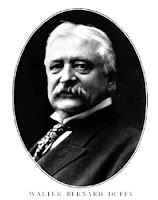SPECIAL NOTICE: This post originally ran on May 30,2011 and was #9 in the series. For reasons unknown it was erased from that slot but the text and photos were still available. Thus it is being recreated here out of the normal order.

Duffy’s story begins in Canada where he was born in 1840, about two years before his father Edmund emigrated to Rochester, New York, and opened a cider refining business. It was a successful enterprise. Edmund soon expanded into selling “wines, liquors, cordials and cigars.” In an 1861 ad he also claimed to be a “rectifier” -- that is, a refiner and blender of whiskey.
The elder Duffy eventually brought young Walter into the business and left it to him when he died during the 1870s. Walter in the meantime had served as an officer in the Union Army during the Civil War and had married in 1868. Upon inheriting the company he promptly expanded the business into other products. .
The 1880s were a time when patent medicines began their meteoric rise in popularity by aggressive advertising and other ploys. Many whiskey makers began to advertise their wares as being “for medicinal use” without being specific as to the ills they were meant to remedy. Duffy took a different approach. He decided to straddle the divide between selling the 15 cent saloon shot and hawking his booze as a cure for specific diseases.

Despite a disastrous foray into the whiskey markets of Baltimore that ended in bankruptcy, Duffy remained president of the Rochester Distilling Company and continued to produce his purported anti-malaria liquor. The success of Duffy’s Malt Whiskey as a cure almost certainly helped solve Walter’s financial woes as he began to attract a national clientele.
Before long Duffy was looking once again to expand outside Rochester. This time he headed west to Kentucky. There, in 1887, George T. Stagg with other local whiskey men had incorporated the Stagg and O.F.C. (Old Fire Copper) distillery in a brand new facility at Frankfort. When Stagg retired because of ill health in 1890, Duffy purchased a majority interest. In 1892 he was elected president of the corporation. A 1898 letterhead, shown here, depicted the Rochester rectifying plant and the Frankfort facility.

 With a guaranteed supply of Kentucky whiskey from Frankfort for his Rochester rectifying and blending facility, Duffy introduced a number of other liquor brands, among them Tromley Rye and Seneca Chief. These were regional labels. The flagship brand remained Duffy’s Pure Malt Whiskey. Its owner energetically marketed it to a wide audience, placing his advertising in national magazines and major newspapers all over America.
With a guaranteed supply of Kentucky whiskey from Frankfort for his Rochester rectifying and blending facility, Duffy introduced a number of other liquor brands, among them Tromley Rye and Seneca Chief. These were regional labels. The flagship brand remained Duffy’s Pure Malt Whiskey. Its owner energetically marketed it to a wide audience, placing his advertising in national magazines and major newspapers all over America.


The Feds did Duffy two enormous, if unintended, favors. Estimates are that before it was repealed after the war, the stamp tax cost the distiller about $40,000, not an inconsiderable sum. At the same time, however, it exempted him from hundreds of thousands in federal and state liquor taxes and allowed him to advertise with some legitimacy as “the only whiskey recognized by the Government as medicine” -- a claim that turned out to be worth millions.
 Even Samuel Hopkins Adams, whose series of articles in Colliers Magazine in 1905-1906 led to the passage of the Pure Food and Drug Act, admitted that Duffy was partially justified in his claim of Federal recognition of his whiskey as medicine. Nevertheless, Adams took particular aim at Duffy’s product because of its claims to “cure” and its inferiority even as whiskey. He also exposed as phony newspaper testimonials to its healing effects by purported clergymen and Temperance workers. Adams’ revelations, however, failed to dampen sales.
Even Samuel Hopkins Adams, whose series of articles in Colliers Magazine in 1905-1906 led to the passage of the Pure Food and Drug Act, admitted that Duffy was partially justified in his claim of Federal recognition of his whiskey as medicine. Nevertheless, Adams took particular aim at Duffy’s product because of its claims to “cure” and its inferiority even as whiskey. He also exposed as phony newspaper testimonials to its healing effects by purported clergymen and Temperance workers. Adams’ revelations, however, failed to dampen sales.
The first head of the Food and Drug Administration, Dr. Harvey W. Wylie similarly sought to shut Duffy down. “I stated that Duffy's Malt Whisky was one of the most gigantic frauds of the age and a flagrant violation of the law, and that there was no necessity that we delay at all in the matter.” After his pleas for prosecution were ignored for two years, the doctor denounced the “determined efforts of my colleagues to protect Duffy’s Pure Malt Whisky from being molested either by seizure or bringing any criminal case against the maker.” Dr. Wylie left office in 1909 without ever having laid a glove on Duffy.


At Duffy’s death, age 70 in 1911, the New York Times, which earlier had highlighted his bankruptcy, listed the myriad companies on which he held executive and director positions and hailed him as “one of Rochester’s best known business men and financiers.” Walter B. Duffy had gone to his grave as a man who had outwitted Uncle Sam and made it pay.


No comments:
Post a Comment